Washburn Rover Acoustic Travel Guitar Review
My family and I went to Montana for a week's vacation out in the beautiful mountains of the Grand Tetons and Jackson hole. Thing is, my son and I went through
serious guitar withdrawals. We even went to a little local pawn shop to look for something cheap to buy... No luck there... We learned our lesson about traveling without our six-stringed friends...
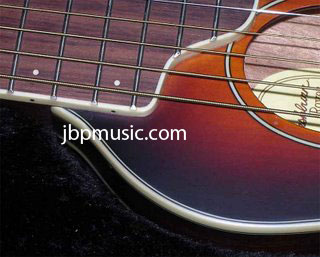
I did a lot of research, playing thinking, and reading. Mrs. Bear said that it would be cool if I went out and found a travel guitar for a treat - to be sure her boys didn't go through withdrawals on later trips. Among the many entries in the travel guitar world, I chose the Washburn Rover. Here's why:
Quick Opinion: The Washburn Rover is a good bargain that has lots of nice features, decent build quality, and great playability. I absolutely enjoy playing my Rover - for more than two years now...
Before you read on, let me explain something very important: A travel guitar is not a warm and brassy hand-made high-end guitar. Travel guitars (all of them) aren't right for recording your next piece for a Pixar film or for playing in a back band for James Taylor or Randy Travis (big fan of both!). A travel guitar is made to feed your playing jones while you're on the road and don't want to tote your Gibson Songwriter around in a jet-powered puddle-jumping tuna can...
You can read about other/competitive travel guitars here at GuitarCenter.com
The Washburn Rover is an excellent all-around choice. It plays great (for something so small) and sounds reasonable enough to make you smile when you sit on the porch, look at the mountains, and play your tunes... Kick back and enjoy your Rover... It has brought music to many adventures. It looks and feels like a nice full-size neck with a little curvy body on the end...
Features: The Washburn Rover is chock full of features for such an inexpensive guitar in such a small size. Let me list out a few for you:
Fully bound body and neck;
Solid (!) spruce top;
Mahogany neck, back, and sides;
An actual, fully-useable 24" scale;
Reasonable build quality;
Reasonably well-dressed and set frets;
Compact enough that it fits in many (probably not all, these days) airline overhead bins - I've done this plenty (and the neighboring passengers can still cram their entire household-in-one-overstuffed-bag bag next to it or under it);
and Simple old-fashioned butterbean open tuners.
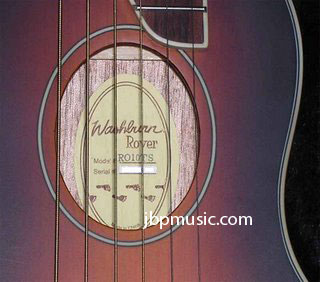
Feature-wise, the Rover is rich. It comes with a strap and an allen wrench. It even comes with an excellent lightweight zippered fabric-on-foam case that is very sturdy and very lightweight. I've carried mine TONS of places and have never felt bothered by carrying around our Rover (we named it "Rover" - surprised?). It is by far the best bargain for the money, given the features alone.
Quality: The quality of my particular Rover is excellent. It rivals most basic acoustic guitars, and even a few middling ones. It isn't the perfect detail of a Yamaha student guitar, but it is very close. Overall, you will probably find a few flaws in the finish, or a bumple or two in the binding.
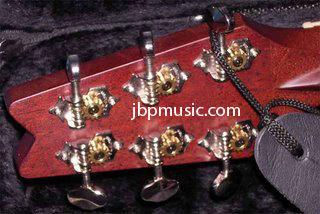
However, the neck is straight and comfortable, the finish feels really quite good on the skin, the neck is finished very well, and the tuners are actually quite nice. Overall, the build quality exceeds many $300 guitars. Perfect? No. Excellent for its cost? Absolutely.
The tuners are the exposed-gear variety. They're not sealed 18:1 Grovers or super-cool Klusons. They're basic. However, they stay very close to being in tune the entire time I'm playing on the porch. That's good enough for me. From an intonation perspective, the Rover is very close to being a near-tempered in-tune instrument. Sometimes you have to sacrifice between tuning for a nice clean D Major chord and a clean warm C Major chord. Using a sweetened tuner like the Peterson StroboSoft or Strobing hardware tuner makes things sound better.
Playability: From the perspective of action, neck feel, and string spacing, the guitar plays awesome - just like a champ. Close your eyes and your fretting hand won't know it is holding a little travel guitar. The action is as smooth as butter (I like 11s in some sort of bronze, usually Ernie Ball Earthwoods of some sort or Martin phosphor bronzes.) It really plays much easier than my larger guitars.
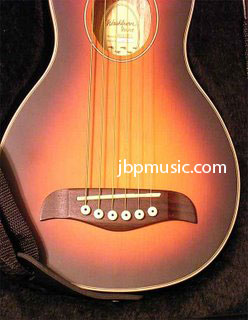
The downside? With any tiny-body guitar (not just the Rover, but all of them), you can't sit it on your leg and relax sitting down with it. If you want to be comfortable and not have to clamp the guitar to your chest, install the included canvas strap. Once the strap is on and around your neck, the guitar actually plays pretty effortlessly. If you don't wear the strap, you'll find yourself fiddling with it all the time (no pun intended, or, maybe pun intended?).
Sound: I've played several travel acoustic guitars. Plug-in electric-earbud guitars, very inexpensive no-name imports, and some from the very big brand names. I love the Martin, truly... but the Rover is warmer and less tinny sounding. Even though I'm a huge Martin and Taylor fan, the little Washburn won my ears over immediately.
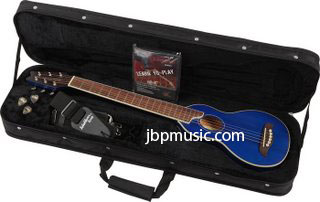
So, what does it sound like? It sounds like a really nice guitar that is played back through an inexpensive stereo with little bitty speakers. It is fun, not too hard on the ears, and actually has an admirable flavor and character. Bear this in mind: none of them sound big, boomy, warm, and growly. The Washburn Rover is definitely the best of them (in the low-cost range). The Rover actually is more warm (with 92/8 phosphor bronze strings) than some of the expensive boutique travel guitars. The strings REALLY make a difference. Don't cheap out on the strings. Just don't expect it to sound like my Big Baby Taylor or my cedar-top Tak.
Value: The value exceeds its current $149 price. It is less expensive than its cousins and even comes with a good case. It is definitely worth much more. It is a high-value, very fun-to-play instrument.
Wishes: Washburn already answered my one wish for this: They now come in neat transparent colors and a new natural color. (Bear in mind, I haven't seen any of the sunburst-brown ones like our Rover in recent months.)
Labels: acoustic guitar, fun, guitar, review, rover, travel, vacation, washburn, washburn rover
Taylor Big Baby Taylor Acoustic Guitar Review
Birthday presents are fun sometimes. Last year, a local fellow sold me his one-year-old Big Baby Taylor for a song. I was thrilled. I've
always wanted a Taylor acoustic, American made, spruce top, and more. I got my wish last October.
I was looking for a moderately bright guitar sound, but one that was also warm enough for making recordings/serenading my family... I like the darker sound of my cedar-top dreadnaught, but I needed a complimentary, tenor-/alto-voiced sound. Clean, crisp, defined.
The Big Baby Taylor fits the bill, and then some... Here's why I love mine...
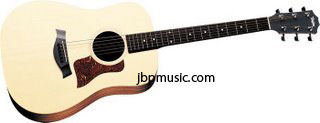 Quick Opinion:
Quick Opinion: The Big Baby Taylor is light, resonant, durable, and very simple. It's comfortable to hold for hours and has a finish that is very easy on the skin. I love this guitar. Where else can you get American-made quality, solid spruce top, ebony fretboard, and nice voicing for so little?
It only took me a couple of minutes to adjust to playing the BBT for the first time at my local guitar store. It was like playing an old favorite guitar, right from the start. I was surprised at its light weight, and more interestingly, its decent sound projection.
You can get more info and pricing information about Big Baby Taylor acoustics (they make a NICE lefty too!) here at GuitarCenter.com
Buy a Big Baby Taylor. They're great instruments all around...
Features: The Big Baby Taylor is fairly basic and simple (a good thing), yet has attributes that make it an outstanding choice for someone who wants nice sound on a moderate budget.
The neck is a nice mahogany wood, with a satin finish and a moderate profile. This one isn't thin like a Strat or a Jackson, nor is the neck a log like the big-necked resonators or 50s electric guitars. The profile is comfortable for most sizes of hands. The neck is actually bolted on with screws going through the fretboard into the body. The screws are completely unobtrusive and do not come into mind when playing the BBT. The benefit of this type of neck is that it can be adjusted without popping the neck out of its glue in its pocket, as you would with a set-neck acoustic.
The ebony fretboard is a very nice touch. It is comfortable, doesn't leave your fingers black with wood dye, and is durable. It looks good, too. The satin black headstock face blends down nicely into the fretboard's color.
The body is non-bound, but has decent edge joints. The rosette is etched around the sound hole. The top is solid Sitka spruce, and the back and sides are laminate. Overall, for a sub-$500 guitar, the body is excellent. The satin finish is very nice and very evenly applied.
Quality: The quality of my Big Baby Taylor is great. All the edges where the top and back meet the sides are clean and smooth. Only once (where the edge was whacked against a corner of something in its previous life) have I found a place where the joint felt a little off... which is to say, no problems at all.
The neck and frets are extremely nicely done, the frets are end-crowned for comfort for your paws, The neck finish isn't too slick or too grabby, it is nice and satin-y. My Taylor's neck is two-piece. There is a joint at the end of the headstock/neck merge. The joint is exceptionally strong and smooth to the touch.
The tuning machines are fine quality and have a decent smoothness. I've not had any troubles keeping my Taylor in tune - even after hours of playing (and even in and out of the case a few times). I found some ebony tuning machine knobs and replaced the factory chrome ones - the look is truly awesome.
The back is a little grainy for my tastes... but it doesn't effect sound or comfort in any way. The nut and saddle bridge appear to be either something like Tusq or some other not-cheap-plastic material. I don't get "pings" when tuning the strings or bending strings while playing.
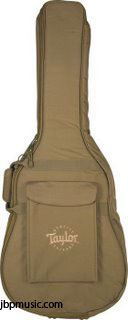 Playability:
Playability: Plays like a charm. Lightweight, nice neck, comfortable body finish, medium-low action (maybe even low-action). I can pluck fairly hard before I get any buzzes. I don't usually dig in to my guitars with a thick pick much (I'm a hybrid pick-and-fingers guy), but it took an effort to whack the sound.
The size of the guitar (15/16) is unnoticeable - it is a dreadnaught, and feels only slightly smaller than my big Tak dread...
The Big Baby Taylor is significantly easier to play than nearly every acoustic I've played in the sub $500 range. It's a real treat - simple, no fuss - I can concentrate on my music. I have no negatives to say about this guitar in the playability department.
Sound: The Big Baby Taylor is surprisingly loud for a 1/5/16 guitar. It has a tone that is a nice mix between warm and bright - depending where you play on the neck/strings and how you play. You can coax very subtle sounds and great volume dynamics from this guitar.
I put phosphor-bronze strings on my Taylor (Ernie's Hybrid Slinky Acoustics, to be exact). I found that the phosphor-bronze strings really brought out texture and character in this guitar. With straight 80/20 brass-wrapped strings, the low strings seemed a bit thin to my ears. My Ernies really made this guitar sing...
I also added brass string-pins to my BBT. I don't know that they really made the sound too much different, but the combination of the phosphor-bronze strings and the brass pins makes the guitar a dream and a treat for the ears.
Value: The Big Baby Taylor is easily a better bargain than many $500-$600 guitars from a variety of manufacturers. It is sort of a "sleeper", one of the best-kept secrets of the acoustic guitar world. It has big value in a medium price. Mine came with a very nicely padded gig bag (much better than most, much!). It's hard to find an American-made guitar (acoustic or electric) in this price range at all, much less one that is a realy pleasure to play.
Wishes: My only wish? A one-piece neck, or at least one that is one-piece from the body to the end of the headstock.
Labels: acoustic guitar, big baby taylor, dreadnaught, guitar, made in USA, review, taylor
M-Audio MobilePre USB Guitar/Microphone Recording Interface and Mic Pre Review
The tune linked to the title of this review was recorded using my iMac and my M-Audio MobilePre.
Tons of people now own computers that are capable of recording music. Processors, hard drives, and RAM are now sufficient to (at least) record music and store it on their disks. Macintoshes with OSX now ship with GarageBand - an excellent means of recording - simple, effective, and transparent (it doesn't get in the way of the creative process).
The market has become filled with recording interfaces for personal computers. There are some that are ultra-basic and well-suited for jamming along with your favorite music. There are also some that are very high-end, with huge mixer interfaces and large numbers of instrument/mic inputs.
What do you do if you want to record one or two instruments/mics at a time? What if your budget is tight, and you want to get started with making music, voice, or sound effect recordings? I've found the MobilePre USB from M-Audio to be an excellent starting point. Although I have more advanced recording equipment and gear, I still keep my MobilePre around to do clean-channel acoustic recordings and to do on-the-go recordings.
Free Shipping and more information about the M-Audio MobilePre here at GuitarCenter.com You can read more about a complete beginner's recording package deal at Musician's Friend here:
You can read more about a complete beginner's recording package deal at Musician's Friend here:

Bear in mind that I could write an entire book on using the MobilePre in the recording process, along with its nuances, its quirks, its strengths, and its weaknesses. But I will keep this review in the realm of just that - a review (not a how-to). Perhaps, I'll have some time someday to write a user-friendly "how to" on making recordings with the MobilePre... Things are so hectic that I don't usually have enough time to write a book or tutorial, though...
 Quick Opinion:
Quick Opinion: The M-Audio USB MobilePre is a superior and excellent choice for simple/beginner computer-based recording and for computer-based recording on-the-go. Throw this box in your laptop bag with an A-B USB cable, grab your instrument(s) and mic(s) and go. You can record sitting on the porch of a beautiful mountain cabin hideaway. You can record that fleeting idea sitting in the hotel room on a business or vacation trip. When one part of the house gets noisy, grab your bits and go to another part of the house. The MobilePre is simple and extremely portable.
It has two input channels, headphone out, stereo mini-plug out, L/R 1/4" out, stereo mini-plug in, and a single USB cable port. It is powered by the USB connection. It weighs less than a stack of CDs. It is clean, class-compliant, and has a wide range of drivers and freebie ("starter" or "limited") recording software options. The M-Audio MobilePre is an excellent basic/beginner/mobile choice.
What's not to like? Go get one.
Usability: Recording interfaces are not always as simple-to-use and elegant as the MobilePre. Really. It's that simple.

There is one 1/4 unbalanced instrument input port on the front (
Unbalanced 1/4? What's that? It's the basic mono plug guitar/bass instrument cable type of input you use to plug your instrument into an amplifier - in use for guitars, basses, keyboards, some types of microphones, and more.). The front port is the left channel input for 1/4. The right channel 1/4 input is in the back of the device, as are both the left- and right-channel XLR (
XLR? What's that? It's the big-diameter, three-pin cable type that is most associated with microphones, but is sometimes used with specially-quipped guitars, amplifier interfaces, and more. Most often, though, most folks will use XLR ports to hook up a mic.) It is kind of weird to have one 1/4 port in the front, and the rest in the back, but it ends up being no big deal after you use the MobilePre for a while. You fall in love with the little box, and the quirky front input becomes second nature.
The left- and right-channel level knobs are easy to use and marked intuitively with a silver pointer ridge. The headphone output level knob is simple, too. I like the little blue light on the front of the MobilePre - it lets me know that the box is active, hooked up, and powered on its USB connection.
You get little green blips on the front panel when sound input is going in to the channels (one each for left and right). The green blip gets brighter as the signal gets stronger. Similarly, you get red blips when your signal is too strong (sometimes called "clipping"). The stronger the clip, the redder the light. When I'm using my MobilePre, I try to let my computer software input meters do their job for me, but it is nice to have the signal strength lights on the front of the MobilePre for when you're not staring at the computer screen.
The rest of the MobilePre box is simple. Standard input/output ports... all are clearly marked, and the 48v phantom microphone button is simple to use. It is light, easy, and intuitive (if you're already familiar with the ports). If you're a complete newbie to recording, devices, and ports, the MobilePre is a comfortable, hard-to-mess-up box with which you can learn.
Compatibility: The M-Audio MobilePre is "class compliant" with some computer operating systems, including Mac OSX. I most often use Mac OSX, and I've always been able to plug in the MobilePre and rip sounds into GarageBand or Logic in no time at all. The MobilePre works with almost every major computer operating system in the consumer market. Sorry Linux and Solaris fans - I'm not aware of an official M-Audio driver for those platforms.
I won't go into a list of what platforms are supported, because it changes more often than this review will. You can see the currently-supported driver list here:
http://www.m-audio.com/index.php?do=support.drivers (opens new window). Bear in mind that as of this writing, Vista is not supported, and Windows XP Media Center is not supported. This may change - check with the M-Audio site.
One important point: the MoblePre works flawlessly and effortlessly with Apple's GarageBand software (part of iLife), and with Apple's Logic Express and Logic Pro software packages. I've never had the first fit, glitch, or issue with my MobilePre in GarageBand 2.0, 3.0, and Logic Express 7.1. NOT ONE. That's cool. If you've got a Mac, and want to record music, words, podcasts, or other sound-based things, the MobilePre is an awesome place to start out.
Note that my MobilePre is a different color than the factory images:
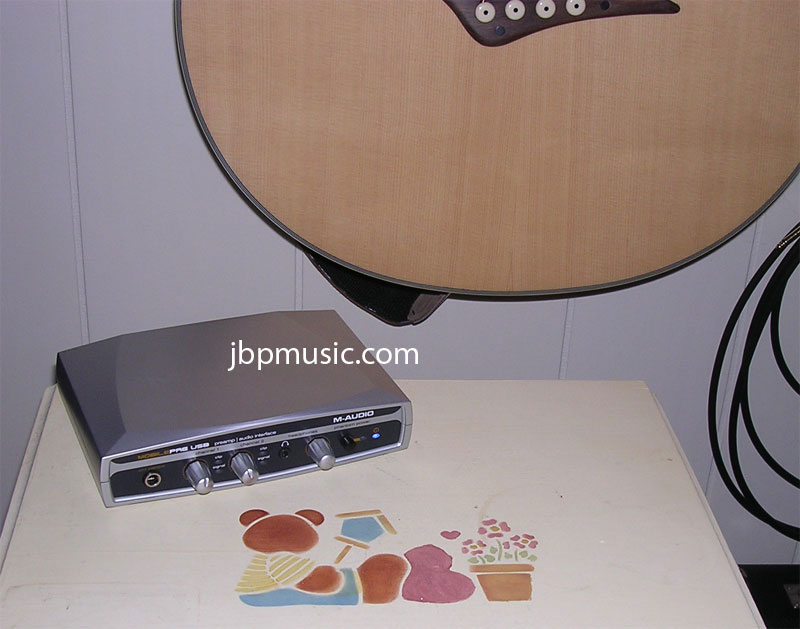 Features:
Features: The M-Audio MobilePre USB interface has excellent features, better than average - and very good considering its price range. The MobilePre has one mic channel with phantom power.It is important to realize that not all budget computer sound interfaces have phantom power (
Phantom Power? That's where the microphone preamp, in this case the MobilePre, provides a little juice to condenser microphones or other mic-like devices.)
Its two-port (two-channel, left/right) design means that you can have two mics recording at the same time, or perhaps an electric bass and an electric guitar, or combinations of both. You can record real two-channel stereo with the MobilePre. (Bear in mind that there are actually four inputs - but only one left and one right can work at the same time.)
Bundled Software (at the time of my purchase) included Live Lite 4 and Reason Adapted (a lite version of Reason). These pieces of software were compatible with both the Windows PCs and Macs in my house. These two programs let you record sound, layer sound, blend, edit, and mix. Both programs are "starter" programs - that is, they are not the full-retail commercial versions of Live and Reason. Some features are not available in the "lite" versions, and certain limitations are in place. If your recording needs outgrow these starter programs, you can purchase upgrades from these starter packages at a reduced rate.
Sound: Clean. Quiet. No bones about it. The M-Audio MobilePre USB box captures as good a sound as you can muster. Of course - your experience, your wiring, recording environment, and recording gear have a great deal to do with the quality of your recording. However, this device adds NOTHING to your recording. It is very clean.
For my acoustic recordings, either voice or instrument (acoustic guitar, acoustic bass, mandolin, banjo, dulcimer, etc.), I use a nice tube pre-amp to warm up the sound. The MobilePre is very, very clean on acoustic inputs, but is very, very quiet. Sometimes it's nice to add some warmth and punch to your acoustic recordings. I'll try to write about that another day. If you'd like questions answered, some basic advice, or have questions, post a contact question to me and I'd be glad to try to help.
Value: The MobilePre USB interface is a bargain. I think it is worth more than it sells for (street price), but I think it is intelligent to market it in the $150 range... (marketing: maybe run occasional $129 "special sales"?)
You can spend $99 to $699 for basic computer recording interfaces - but no single one of them can compete with the features, number of ports, extreme light weight, durability, and overall compatibility of the MobilePre.
I have been asked
a great many times about my opinions of starter/beginning recording devices. It is rare that I don't recommend the M-Audio MobilePre. Even more interesting, I've found that folks keep their MobilePres and still use them
after they become more advanced at their craft, and after they've bought more advanced and expensive equipment. I have more than one interface, and I'm still using my MobilePre for certain acoustic things and for travel.
Wishes: I think that it should be very clear in packaging, or more importantly, web site data, what computer operating systems are NOT supported at the time of purchase, or at least give folks a super-simplified means of looking up compatibility before they purchase.
I like VU Meters. They're cool and they make me remember the days of old tube stereos - VU meters would be nice. But, since the MobilePre is so inexpensive and so lightweight, I guess VU meters can be left out. Perhaps a "MobilePre Pro" that would give us all back access, lit VU meters, and dual phantom power (one for both left and right)? M-Audio, are you listening? :-)
Labels: 1/4, bass, computer recording, cubase, garageband, guitar, home recording, home sound studio, home studio, live, logic, music, reason, stereo, voice, XLR
The Epiphone SG Special Review
Epiphone SG Special Electric Guitar Review
Bargain instruments are prolific in the modern instrument-sales market. There are large numbers of manufacturers, and there are a huge range of choices for the consumer. Generally, the competition and diversity of designs give consumers a wide range of choices for getting started with electric guitars.
About two years ago, my son wanted to go from using one of my instruments to having a guitar of his own. We talked about what kind of music he was enjoying the most, and what he liked in guitars. I played a fair number of beginner’s guitars (in the less-than-$150 range), showed him several pictures online, and took him to the guitar store a few times to play a range of different instruments. He settled on the venerable Epiphone SG Special (sometimes called the
Epiphone SG Special II because of its dual humbuckers.)
It was an excellent choice – one that is still serving him well two years later. He still enjoys it, and I enjoy borrowing it from him from time to time.
Quick Opinion: The Epiphone SG Special is very light, well-balanced, and has respectable sound. It has reasonable intonation capabilities, and the craftsmanship is at or above par for instruments in its price range.
As an all-around instrument, the SG Special competes very well on quality, price, features, and looks. This is a high-value instrument that is very reasonably priced.
Free Shipping and more information about the Epiphone SG Special II at GuitarCenter.com Playability:
Playability: Playability is the Epiphone SG Special’s strongest suit, next to its price.
The neck is typical Epiphone, slim but substantial, smooth painted, and medium width. It is a shallow “C” profile (in my opinion). It is very easy to access the entire fretboard with this guitar, largely due to its faithful rendition of the classic SG body design.
Whether you like your strings high up (for slide playing, and those with extremely strong hands), or your strings low – this neck serves very well. The frets are a little thin for my tastes, but they do get the job done in a reasonable way.
The balance of neck to body is excellent, particularly when standing and using a strap. The guitar is light and airy in the hands, but is
surprisingly resonant when it is played. I was amazed at how much the body rings with the notes. The light, thin guitar body is unobtrusive to the player’s picking arm, although it is not contoured for ribcage and pick arm rest.
The SG Special came fairly well set up from the factory. The frets were average-dressed for a guitar in this price range. There weren’t, however, any truly bad frets, sharp edges, or major string buzzers (a few spots on the neck, but MUCH less than the typical bargain-priced guitar).
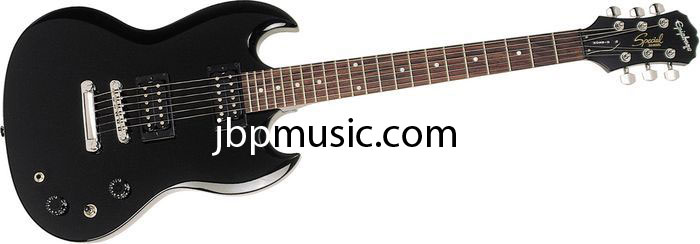 Features:
Features: The Epiphone SG Special electric guitar is almost par for features in its price range. It is thoroughly average, and has some things that outweigh others in terms of their value.
The body is great. SGs are fun and easy to play, and are a great all-around choice. The neck is a bolt-on affair, with a shallow pocket in the body to accept the heel of the neck. The feel of the neck and the feel/balance of the body are the strongest positives for the SG Special’s feature list. These items, coupled with this guitar’s sound, make the SG Special a good choice for most beginners.
The tuners are below average in quality. Most Squiers come with much better tuners. However, many bargain manufacturers use the same type of tuners (maybe even the same manufacturer? Not sure, they look the same, though). I think this was the first thing we did to mod the SG… we put Grover Rotomatics on, tuned up some new strings, and have seen significantly better tuning stability and accuracy. The Grovers made it much easier to do alternate tunings with thicker strings… the OEM tuners did not hold up well with rock-style thicker strings.
The SG Special has two potentiometer knobs, one for tone on both pickups, one volume for both pickups. The pickup selector switch allows the player to choose neck only (Rhythm), both pickups (a little more punchy and a little louder), and bridge only (Lead) for more clarity, growliness, and grind. The neck pickup is best suited for smooth sounds. The bridge is fairly hot/loud, and serves rock styles very well. The pickups are average in quality for this price range, perhaps a little more than average. They are largely quiet, and are the open-face (no cover) variety.
The pickups are easily adjusted with standard screw setups. The frets are a little on thin and shallow side, but work adequately well in the lower positions of the neck. Towards the body, the frets are a little small for my tastes – I like seeing taller frets for cleaner high notes.
Sound: The Epiphone SG Special sounds great through a nice amplifier. It holds up surprisingly well against guitars that can cost almost twice as much.
Although the pickups certainly aren’t on par with Gibson high output humbuckers or Seymour Duncan humbuckers, they are actually quite nice for a $150 guitar. The stock pickups can do the distortion thing pretty well, and can even pick up enough signal for pinch squeals and slap-plucks. The output of these pickups is pretty good, if not above average. They lack the smoothness and dynamic capability of better pickups – but they do well for beginners.
I was able to set the intonation of this instrument to very nearly ideal. The neck/length/scale is good for basic set up, but isn’t quite perfect. However, I’ve seen bargain instruments that don’t even come close to the SG Special’s tune-ability.
Value: Brand new, out of the box, the SG Special was ready to be played. I just tweaked the intonation and string height at the bridge, tuned it up, and it was ready to go. The SG has simplified tone and volume controls, and is very easy on the hands… Given the overall quality of the instrument, and the sound it makes, this is an instrument that is in the $189 range for
street value - one that you can get for significantly less at your favorite brick-and-mortar vendor or local guitar store establishment.
Overall, the SG Special II is a bargain – one that will last a beginning guitarist for a decent amount of time.
Wishes: I do think this instrument could use two volume and two tone controls. I also wish it was offered in other colors (in addition to dark red and black). The tuners could have been nicer cast-metal tuning machines.
Labels: electric guitar, epiphone sg, epiphone sg special, guitar, instrument, sg, sg special
2006 Fender HSS Stratocaster (Strat) Review
Fender Standard HSS Stratocaster (“Fat Strat") Review
Electric guitar: Effervescent, visceral, emotional, and motivating…
Whether or not you start out as a Fender fan, the HSS Stratocaster is an extremely flexible instrument that is sonically diverse and very playable!
I was looking for an instrument that was comfortable and had a sonic range of sounds, was comfortable and affordable, and would compliment my Epiphones, Parker, and Fenders.
I love the
feel of a Stratocaster – the light weight, the wonderful ribcage cutaway, the warm rounded shoulder for the picking arm, and a simple, clean neck design.
The Fender Standard HSS Strat is all the things a Stratocaster is - but adds the crunchy, punchy sound (to the bell-tone Strat sounds of the neck and mid pickups) with its bridge humbucker.
At first, I wasn't really interested in the idea of a humbucker-enabled Stratocaster – Strats have always been “three singles" to me. However, after I played them many times over, I discovered just how sweet they are and how versatile they are.
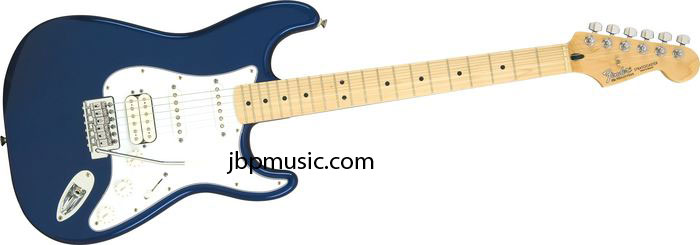 Quick Opinion:
Quick Opinion: The Standard HSS Strat is a dream to play. It has sounds that crunch like a Gibson and sounds that sing like an old Stratocaster. The 2006 (and later) Standard Strats (including the HSS) are deeply improved over previous years, and it shows. The new tremolo block, pickups, frets, and finishes are outstanding.
The HSS Standard MIM Stratocaster isn't currently in production (as of 10/2009), but you can see more about HSS Strats and get Free Shipping from GuitarCenter.com Playability:
Playability: The HSS Standard Stratocaster plays with great ease. It has wonderful string-bending capability, has a body shape that lets you forget that your pick arm is on a guitar body, and has a neck that is medium-broad for pretty good finger-picking capability. (In fact, if you're a finger-picking or hybrid-picking player, the Fender Strat neck and fretboard are among the most comfortable and easy-to-play on the market.)
As with most any Strat, the pickup selector switch is easy to use and is well within the pick hand's reach. Since the tonal variety of an HSS Strat is often more interesting and varied than a Standard three-single pickup Stratocaster, you may find yourself hitting the 5-way pickup selector switch quite often – varying your sound has never been so easy.
The subtle, non-gloss neck finish is great for when your hands are damp with sweat – your hands can still slide around the neck pretty well, but you can also get a good grip for those hard-to-finger chord shapes.
Features: The Fender Standard Fat Strat has all the features you'd expect from Fender's latest Stratocaster offerings. It has the famous Fender 5-way pickup switch, skunk-striped hard maple neck, a fantastic light-weight body, and extremely well-made electronics.
The pickguard is three-ply on most models (for example, White-Black-White). The back cavity cover is pretty standard for this type of Strat, generally a one-ply white cover. All the plastic parts are color-matched to the pickguard.
The tremolo setup is a standard three-spring mechanism, with string-through saddles and bridge. Tuning stability is average for a Stratocaster – although I have added a
tuning stabilizer (tremsetter) to my HSS for a boost in stability

.
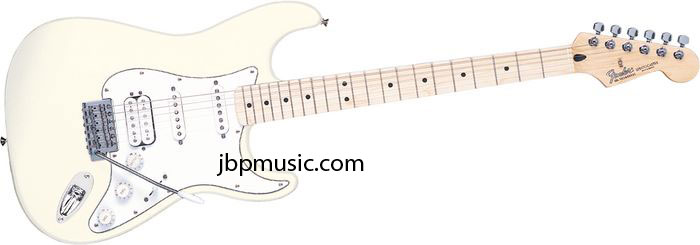 Sound:
Sound: Sound, sound, sound. That's the main reason for buying an HSS Fat Strat over a three-single Strat.
With the neck and mid single-coil pickups, you get the strong, bell-like tones you'd expect from a Stratocaster. In this respect, especially with the 2006 and later Strats, the HSS will not disappoint. These newer pickups seem stronger and clearer – and have somewhat less noise when playing through a strong tube amp.
With the Fender humbucker on the bridge, a whole new set of sounds come out of your Strat. This humbucker is actually pretty hot in output, and is really crunchy. It does blues, country, and hard rock
very well (but can be dialed back for super-smooth sounds of jazz, contemporary gospel).
The pickup switch configuration is as follows:
Position 1: (switch all the way towards the bridge) is full humbucker, no tone control in the sound. This is crunchy, can be dialed up loud, and is super-clean (good midranges, too).
Position 2: You get the front coil (split) of the bridge humbucker and the middle pickup in combination – the lead (closest to the input jack) tone control effects this combination. This position is very bright, and is louder than the standard Stratocaster bell-tone. This position is good for cut-through-the-band lead tones, but without all the crunch of the humbucker.
Position 3: This position opens up the middle pickup only, with the lead tone control affecting the sound. This sound is the traditional Stratocaster mid pickup sound – somewhat warmer than the bridge, but not as mellow as the neck.
Position 4: This position sets up the middle and neck single-coil pickups together, with the lead
and rhythm (middle) tone controls shaping the sound. Warm, but still lots of belltone.
Position 5: This is for the neck pickup only, and uses the rhythm tone control for sound shaping. This pickup position is the warmest of the single-coil sounds. By far, this pickup selection is the mellowest.
Value:This is an extremely high-value Stratocaster. It is worth more than its street price, probably in the $425 to $450 range in
actual value. You get lots of really nice options (humbucker, coil-split combination) to add to the versatility of your favorite Strat sound and feel.
Folks with a one-guitar budget who need/want to play lots of different styles of music should seriously consider this instrument as a front-runner for purchase consideration.
On my HSS Strat, the fret ends are cleanly set, the height of the frets is very good, and the intonation was pretty close (as set up by the factory). It didn't take very long for me to set the Strat's intonation to a very serviceable and easy-to-play tuning setup. The body finish is just right, no flaws. The neck is straight and is well-set. The standard Super 250 Fender Bullet Strings are wonderful.
Wishes: There isn't a lot to wish for with these Strats. I do wish it was offered with a V-shaped neck as an option, perhaps also with a tinted and V-shaped neck as an additional option – similar to the treatment on the 2006-> "50's Strat" issues coming from the MIM factories. I think all Strats should be offered with optional locking tuners (for those who don't know how to replace their own tuners).
Labels: electric guitar, fender, guitar, HSS, humbucker, single coil, strat, stratocaster
Parker P-36 Fly-cousin Electric Guitar Review
 Parker P-36 Guitar Review
Parker P-36 Guitar Review
I play instruments each day – with joy, I might add. Part of the real pleasure of making my music is my enjoyment of interacting with
different instruments. One of the BIG things that is important to me in an instrument is flexibility of sound.
Some instruments are very well made and don’t have any flexibility beyond the musician’s ability to alter sound. These instruments are important, and are the basis of any “sound library.” A superb oboe, trombone, piano, or trumpet can be played in many different sound-wise ways. But, some instruments allow for added flexibility. Electric guitars, basses, and other electric instruments can have built-in sound-shaping capability.
I recently went looking for a very playable, but very flexible guitar to add to my sounds. I had read about Parker guitars for quite some time – but I brought focus to Parkers because of some truly interesting capabilities. This review unfolds a bit about my decision to go with a Parker P-36.
Quick Opinion: The Parker P-36 is a pleasure to play. Its sonic capabilities are very wide, and the relative price is a bargain. The Parker P-36 is sort of akin to the superb set-neck and fabulous USA-made Parker Southern Nite Fly. As is often said, the apple doesn’t fall far from the tree, and the P-36 doesn’t disappoint.
The P-36 is feature-rich, flexible, playable, and fairly comfortable to play (comfortable even for playing long periods of time). The P-36 I picked had one nice little extra feature – the maple fretboard looks nicely flamed – a beautiful and nicely-done touch.
The P-36 appears to no longer in production, but you can see more information about Parkers and get Free Shipping on Parker guitars and basses at GuitarCenter.com Playability:
Playability: The P-36 has a comfortable radius on the fretboard, excellent fret height and width. The all-maple neck and fretboard is extremely accessible and feels "quick." For those of you who are big Fender fans, the P-36 neck is a comfortable marriage between the wider, more arced Strat neck and the narrower, quicker, flatter Tele neck. Overall, I’d give the neck a solid “A.” One distinct advantage of having this instrument is that switching among 6-string Fenders and the P-36 during a session is effortless and doesn’t cause the guitarist to have to re-think much of the scale reach in his/her head.
The interesting, trademark Parker Fly-shaped body of the P-36 allows for easy access to the whole fretboard - with middle-finger access to the upper 6 frets being fairly comfortable to those with longer fingers. After months of playing my P-36, I’ve found very few spots in the fretboard that require a funky hand shape to reach.
The body is nicely contoured. The overall thin-ness of the body, and the wonderful ribcage scoop behind the top horn make the guitar a favorite in our house. Just strap the P-36 on, and the guitar seems to fit against the body as if it was custom-made. Although the top lower-bout of the guitar body doesn’t taper for the pick-hand arm, the thinness and gentle shape of the top makes the lower bout fairly un-intrusive. To reiterate an important point, the guitar is well-balanced, and actually feels lighter than it actually is. The body’s Ash wood is a serious asset in this aspect of playability.
Features: The features of the P-36 is where it truly shines. The excellent marriage of magnetic standard-type coil pickups and piezo-bridge pickups give
huge combinations of sonic choices. Combined with the extra-flexible volume and tone control layout, a single P-36 can sound like many different guitars, each by just flipping the small piezo and/or magnetic pickup-select switch. Combined with the familiar neck-both-bridge magnetic selector switch, just a flip, dial, and click causes the P-36 to sound like a completely different instrument.
The P-35 has the fun and interesting headstock of the Fly clan, EXCELLENT genuine Grover 18:1 precise tuning machines, a lovely and comfortable maple fretboard, and an easily-accessible truss-rod adjustment wheel (you don’t have to remove the pickguard to adjust the rod – just use the notched wheel to loosen or tighten).
The tightly-glossed Ash body is done extremely well, and looks good to boot. I chose the blonde finish (what was it they said about blondes ;-)?). Overall, the P-36 is a very high-feature guitar for the money.
As an added bonus, the P-36 sells with a better-than average Parker Guitars gig bag.
Sound: Sound is a strong suit of the P-36. The two single coil pickups are very low-noise, but strong enough in output and aren’t gnarly. The sound from the magnetic pickups is on par or slightly better than comparable singles in guitars in the P-36’s price range. The Fishman piezo saddle pickups are crisp, even, and sound very good.
The piezo pickups add an almost acoustic quality to the sound of the P-36, when the pickup-type selector is set to piezo or piezo-and-magnetic. Although some amplifier types will cause the piezos to quack a bit under load, the piezos actually outperform almost all the bridge/saddle pickups I’ve tried.
The P-36’s sound has very good sustain for a bolt-on neck and moveable saddle guitar. The sound is very consistent throughout the life of the strings, and the tuning stability of the P-36 is well above average.
Value: I believe that the Parker P-36 is well-priced at its “street-price” level. It compares well with many instruments in the $600-$800 range – but with a boatload MORE features. Given a budget in this range, I feel as though I got a bargain – considering the sonic choices now in my sound palette. Since the P-36 is really in its own ballpark (more or less), it is difficult to compare it to the same price-range guitars from many excellent brands. That said, once you pick up a Parker P-36 and plug it in, you’ll be hard-pressed to walk out of the store without it.
Wishes: I have almost nothing to cite as concerns on the P-36. If I was designing the P-36, I think I would only ask for a little difference: a set neck. The bolt-on neck is fabulous, don’t get me wrong… I realize that one of the many feature upgrades going to a Southern Nite Fly is the Fly’s set neck. I also think that better availability of hard cases would also be nice.
Labels: electric guitar, fishman, guitar, p-36, p36, parker, piezo
Epiphone Les Paul Classic Quilt-Top Review
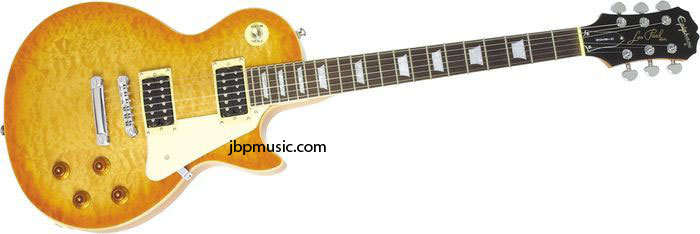 Epiphone Les Paul Classic Quilt Top Review
Epiphone Les Paul Classic Quilt Top Review
Over the years, there have been many guitars I have played and loved. One guitar, however, has been consistently my favorite to play - the Les Paul. I love Firebirds, Stratocasters, Telecasters, SGs, Ibanezs, PRSs and lists of others. But, time after time, I always come back to a Les Paul. The way they play, sound, feel, and look just says something to my soul. I know that Les Pauls aren't for everyone - no problem. They're just wonderful to
me.
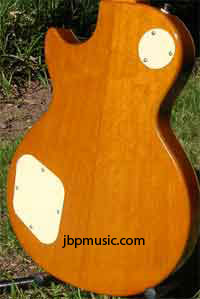 Quick Opinion:
Quick Opinion: The Epiphone version of the Les Paul Classic Quilt Top is a well-done rendition, with great features and decent sound. The guitar does not approach its Gibson cousin, but is definitely worth its price and then some.
The Epiphone Les Paul Classic is not currently in production, but you can find out more about Epiphone Les Paul guitars and get Free Shipping at GuitarCenter.com Playability:
Playability: In the world of Les Pauls, there are two main camps. Those that like thick necks and those that like more modern C-shaped necks. The Epiphone Les Paul's neck is much more comperable to a modern Tele or Strat than a 50s Les Paul. The neck is slightly less beefy than the 60s-neck Gibson Les Pauls, and significantly less beefy than the 50s-neck Gibson Les Pauls. If you're a modern Fender fan, the Epihpone will probably feel much more at home than the Gibson necks. If you're used to Ibanez electrics or modern ESP/LTDs, for example, you'll find the Epiphone very similar.

The neck plays like greased lightening, and is very comfortable from a grip point of view. The string spacing is excellent for most hands, and the string height is actually superb - right out of the box. In general, Les Pauls have a short-ish scale length (means, the length of the string is a little less than the average guitar). The shorter scale makes thicker strings a little more comfortable to play, and makes reasonable string-bending possible with 10s or 11s.
The balance of neck and body is good, and the fretboard is comfortable and smooth. Some may find the weight of Les Pauls (in general) a bit much to lug for hours at a time, but I think it is a reasonable trade-off for the MILES of sustain and depth of the guitar's sound.
Features The Epiphone Les Paul Classic Quilt top is very high in the features list arena. Were this a Gibson, the features of this guitar would be between a Les Paul Studio and a Les Paul Standard. The single-ply cream-colored binding is applied to the top edges and the fretboard. The back is pretty much a natural mahogany color, and the entire guitar is gloss finish (including the back of the neck). The quality of the smoothness of the finish is very good, although my particular guitar has a few blemishes underneath the top coat on the back (almost like a filler was applied to the wood, then finished over without coloring the filler).
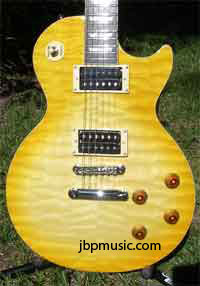
The Classic Quilt Top is actually a beautiful instrument, with mahogany body and quilted maple carved cap/top. The fretboard is a comfortable and nice quality rosewood, and the headstock overlay is fairly well done. The stop-bar tailpiece is standard Gibson stuff, as is the Tune-o-matic bridge. The guitar sports two tone knobs and two volume knobs, with one of each for each of the two pickups. My Classic came with superb, chrome full-sized Grover tuners. Epiphone appears to have made the switch from the jade-keystone-two-screw vintage tuners not long before my instrument was made - all the catalogs and internet sites still showed the guitar with the vintage tuners and not Grovers. (As an aside, I found some new Gibson-authorized Grover chrome tuners that have the keystone/tulip shape for the tuner buttons - and they were a direct replacement for the factory Grovers. I just like the keystone shape of the tuners better than the butterbean shape.)
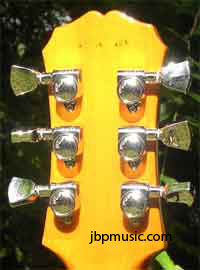
Overall, the Epi Classic is complete with features that compare favorably with other, nicer Les Pauls.
Sound: Sustain, sustain, clarity, clarity, and clarity. When you look up sustain in the dictionary, there's a picture of my Les Paul. Nuff said.
The pickups are a little on the low-output side (although still better than the Classic's less expensive siblings). When compared to Burstbuckers or Classic Gibson pickups, the edge, bite, and growl are significantly more tame with the Epi's pickups. But to put them in real perspective, they are more versatile, warmer, and more creamy than any other humbucker I've played in guitars in the same price range. Pickups are almost a matter of preference - when concerning their overall sound. Some like the visceral sound of EMGs, some like the mellow twangy-beefy of Fenders, and others like the true-blue broad-spectrum sound of Burstbuckers. The pickups in the Epi are most comperable to the Gibson humbuckers, but with less output and less tonal range. I realize I ramble on this part of the subject, but I think most will agree that you will always want
more pickup sound (unless you've bought a top-of-the-line Gibson/Fender/Etc.).
The sound of this particular Epi Les Paul is good for rock (almost all types), good and gutsy blues, electronica, and some forms of traditional metal.
Value: This is a $550 guitar in value (not 'retail',
'street'). This guitar is significantly nicer than the lower-end Epi Les Pauls, and is an excellent value for the money, the sustain, and the features.
Wishes: I love my Les Paul. Even when my budget will allow me to buy the Gibson Les Paul Standard of many a dream, my Epi will still get lots of play time and recording time.
However - The finish flaws on the back side could have been avoided. Also, as seems typical of many Chinese Epis, my guitar's lead wire solders were not very good. I had to re-solder most of the wiring into the pots before I could get the guitar to behave correctly (as was true of at least 6 other classics at my favorite guitar stores).
I do wish the pickups were covered with nickel covers. I do think the sound might change a bit with nickel covers - but to me, after looking at Les Pauls for so many years, nickel-covered pickups were traditional. Perhaps this model could be offered with more than one type of pickup system.
Labels: classic, electric guitar, epiphone, epiphone les paul, guitar, set neck
Squier (Fender) Affinity Telecaster Tele Review

Some time back, I was in search for a low-action, fast-neck guitar that could both
twang and growl. On top of the need for such a beast, I had a very small amount of cash with which to work. Since I was lucky enough to have a double-humbucking guitar at the time, I really just needed… a
Telecaster™. Before I was seriously blessed by my brother’s gift of a Blonde American Deluxe Telecaster™ (thanks, Bro!!!), I needed the use of a Tele™ for more than a year.
Enter the Squier™ Affinity Telecaster!
I went to my usual haunts, the Guitar Center and Sam Ash (my wife wishes I hadn’t found those places :-) - but she’s so wonderfully tolerant!). I played 6 examples of Squier Affinity Telecasters. I tried several different individuals – all of which had been whacked around pretty good as floor models. I was blown away at how this particular variety of guitar felt and sounded. The key here is that the two largest concerns I have when purchasing guitars are: 1) The sound the guitar can make through average amplifiers (I’m on a budget – no $2500 Buddhas here); and 2) The way the
guitar as a whole feels when I’m playing it.
I found one particular Squier Tele that I enjoyed a great deal, but it was not the color I wanted, and it had too many sales-floor-bang-ups. If I’m going to buy a bargain guitar, I really want the color I want and I don’t want one that has been whacked up by anyone but me or my son. I ended up settling on taking a chance with an online purchase from Musician’s Friend
Free Shipping and lots of information about the Squier by Fender Affinity Telecaster here at GuitarCenter.com
- I’m glad I did.
Quick Opinion: I generally like Fenders, but my budget was
really tight this time around.
Even the very modestly-priced $399 Mexican-made Fender Tele was way out of reach this time around.
That said, I was REALLY blown away by the quality, finish, playability and sound of this $169 Tele! If I closed my eyes and picked up the Fender and the Squier in succession, I would be hard pressed to tell the difference. The sound is better in the Fender, but not in terms of leaps and bounds. The neck and the pickups of the Fender are better (realistically), but the
playability of the Squier is fantastic!
Playability: The neck is a delightful satin-finish flat-ish "c"-ish shape hard maple two-piecer.
The frets are finished surprisingly well, with only a few end-burrs, and no inconsistency in fretwire height or finish. The frets could have been polished a little nicer – but you can do that yourself pretty easily with the right polishing paper/cloth. The scale is just right – medium. There are no buzzy frets on the example I purchased. The string height is very low, but only exhibits a little buzz – the buzz does not carry out into the sound through the pickups (only acoustically). I decided to leave the string height as-is – and replaced the factory strings (.09 Supers) with Stainless 3350s. The neck is really quick and the strings play out like hot butter! The only drawback is that the neck is a little thin for me (others may find it to be great, but I like to get a grip on my guitar necks).
The weight and balance of the guitar as a whole is excellent. It’s not overly neck-light (as are some Squier instruments), and the feel of the instrument’s construction is solid. The instrument is not as light as an Ash Tele, but won’t cramp your style in hours of spankin’ the fretboard plank. The hardware was finished flawlessly, and the electronics are clean enough.
Sound: Despite the slightly buzzy (normal for $169 guitars) pickups, the output of the pickups is surprisingly strong. If you were to put some Tex Mex Custom shops or some
GFS Alnico pups (I’m gonna get some fairly soon myself! They’re a bargain!) in this guitar, it would absolutely scream - for not a lot of bucks. I found that running this guitar through some interesting Line6 guitar models made this guitar really sing!
Value: This is a $249 guitar in value (not 'retail',
'street'). The sound, quality of make, and appointments are top-notch for a bargain electric guitar, excellent. To get a better instrument, you’d have to spend $399. This guitar is made in China, but you would have difficulty telling its origin from the excellent build quality. I have since seen the
Butterscotch Blonde version of this Tele – looks great!
Features: This is an excellently-designed instrument. It has the bits needed for daily use and for recording alike. The finish on the body is even and consistent. The neck finish is without remark, and the tuners are remarkably good for this price range… Overall, Telecasters are simple and genius at the same time.
A Small Issue at Delivery: When I received my Squier Tele, the nut had been cut incorrectly at the factory. The slots were not spaced very well, and the overall height of the nut was much too low. The 1st and 2nd strings had a bind-buzz from pinching at the nut, and the strings were way too close to the first and second fretwires. I called Musician’s Friend that day, and (as is very much usual), their customer assistance was excellent – they shipped out a
GraphTec replacement nut (an upgrade – I don’t have the tools to slot an OEM Fender nut) immediately at no charge. I replaced the nut on its arrival and have since become a
big fan of GraphTec’s guitar nuts. The bending is easier and the intonation stays put longer when I’m using one of their nuts. The nut was a little bit wide for the Tele’s neck, but not enough to get sideways about it – I don’t have a problem with the fact that it is not flush left-to-right.
Wishes: I'm glad to have the GraphTec nut, but I wish I hadn't had to deal with the problem. A tinted neck would really look nice!
Labels: affinity, electric guitar, fender, guitar, squier, tele, telecaster
Ibanez ArtWood AW 40 Acoustic Guitar Review
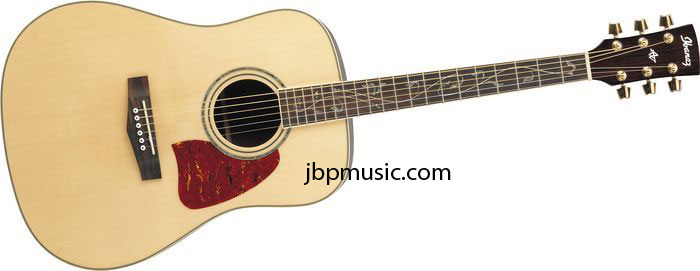
Update, October 2009 Sigh... the AW40 is no longer in production. I've since found a used one that had been dropped and have rehabilitated it into my mountain-trips guitar. Lovely, wonderful, plays well, sounds awesome, even after it was dropped (hard) by its previous owner.
I had been looking for an affordable solid-spruce-top 6-string acoustic for nearly a year. I was looking for medium-bright sound that also had crisp, clean basses, but with good resonance, easy playability, and good intonation. Finding a guitar that meets these expectations, and is under $400, is a real challenge.
I started my quest by playing countless acoustics at both my local guitar stores. I probably played more than 200 different low-cost acoustics – specifically looking for my target attributes.
I eventually discovered the Ibanez AW 40. This delightful acoustic guitar is from Ibanez's ™ ArtWood™ series acoustics. The street price for the AW 40, both locally and on the street was $200US. This new AW 40 turned out to be the guitar I purchased – and I’m very glad I did. I bought the AW 40 (mine is named “Rosie”) from my Sam Ash guy and have played it quite a bit – it has been used on many songs across three different acoustic albums of mine.
Quick Opinion: I chose to play the AW 40 on and off for a few weeks before I actually purchased it. I wanted to play several other contenders in comparison just to be sure:
The AW 40 is a bargain, and is an excellent purchase! It has excellent craftsmanship, good features, and sounds like guitars that cost $200-$300 more. Purchasers of the AW 40 are VERY unlikely to be disappointed! This is the second-most-played-acoustic I own.
Free Shipping and more information about Ibanez Artwood acoustics here at GuitarCenter.com Playability:
Playability: The neck is a delightful satin-finish soft “c”-ish shape (the rosewood color is unique, too). This guitar plays nicer than the gloss-finish necks of many other guitars in this price range.
The frets are finished nicely, and are just the right balance of height and thickness. The scale is just right – medium. There are no buzzy frets on the example I purchased. The string height was a little too low when I brought it home, so I had to change the truss rod just a tad to stop general string buzz. Once I raised the strings a bit, the string sound was flawless.
The weight and depth of the AW 40 body is excellent, and the fretboard feels smooth and quick. The 1 5/8” width nut is just about right for this particular neck.
The AW 40 ships with
D’Addario EXP bronze strings (opens new window), starting with .11 width on the 1st string. These particular strings are really quite nice (especially if you like coated strings), and are appropriate if you like a little darker high sound. After a week or so with the stock strings, I switched to D’Addario EXP phosphor-bronze .11s to give me the crisper bass sounds I was seeking. Once the new strings were installed, this guitar has been giving the low-end
Martin™ guitars (opens new window) a strong run for the money.
Sound: Crisp, crisp, crisp, resonant, and more crisp! The solid spruce top lives up to its job very well. The bass sounds are clean and clear. The 1st and 2nd strings above the 13th fret are a little thin for my tastes. The midranges are clean and rarely muddy for finger-picked notes. The body resonates nicely against your chest and hands when the guitar is played. Very nice!
Value: This is a $450 guitar in value (not 'retail',
'street'). The sound, quality of make, and appointments are top-notch, excellent. To get a better instrument, you’d have to spend at least $499. This guitar is made in China, but you would have difficulty telling its origin from the excellent build quality.
Features: This is an excellently-designed instrument. It has the bits needed for daily use and for recording alike. The body is fully bound in a nice white-with-black stripes motif. The rosette is a beautiful abalone-ringed decoration. The headstock has inlaid pearl Ibanez logo and AW logo. The back of the guitar has a nice black-white center stripe and nicely matched halves. The red-ish shell pickguard does seem a bit bright for the cream-colored spruce top, but is pleasant enough.

An unexpected and
BEAUTIFUL feature of the AW 40 is the
abalone "vine of life" fretboard inlay. This is truly a nice-looking addition, and is really nice and unique. I always get good comments on this feature every time folks see Rosie.
The stock tuners are mechanically sound, but felt a bit uncomfortable. In addition, the gold plating on the tuners was not well done at all. It looked as though the gold had barely been applied (this was true on all the examples I played).
More about the tuners: I ended up replacing the stock machine heads/tuners with Grover™ Rotomatic™-style 14:1 tuners. The screw holes did not match the factory screw placements exactly, but I felt it was worth it to drill new screw holes and putty the old ones – and gain excellent tuners. I bought chrome Grovers, and they look very nice with the rest of the guitar’s appointments. The Grovers function flawlessly and are, well, they're Grovers ('nuff said!).
Wishes: The tuners really should have been better-made and better executed. Even the Yamaha™ basic guitar tuners work better and look better than those on the AW line.
Labels: acoustic guitar, art wood, artwood, aw 40, aw40, guitar, ibanez, instrument
The Jimmie/Jimmy Vaughan Tex-Mex Fender Stratocaster Review

I've been looking for just the right Fender(tm) Stratocaster(tm). My heart wants a nice , Custom Shop American Strat(tm), my wallet wants a Squier(tm) Strat.
Let me begin by saying that the American-made Strats and Telecasters are superb, and that there is no substitute for a Custom Shop or high-end Strat/Tele if you're looking for a high-end instrument. With that said, I've been playing an extremely wide variety of Stratocasters for quite some time now. My big question has been, how can I get just the right playability, feel, price,
and sound for less than $1000US??? This review answers lots of those questions for me, and I hope will help you, too.
My Previous Strat; I had the basic Squier Strat with the maple fretboard for quite a while. It was extremely well-made, very reliable, OK tuning, and OK intonation (it could not be adjusted to the point where the tempered tuning I use would stick...). The neck was a very soft "C" shape, and the body was the lightest Strat I've ever played (it was even neck-heavy when you played it with a relaxed strap position). I made several great pop tunes with that guitar. I sincerely think that the little black Squier strat is absolutely phenominal for a beginner, or for someone who wants a Strat to take to the beach on vacation (don't get beer or sand on your Custom Shop Strat!). The maple fretboard variety is a favorite of mine. I like the feel, the hardness of the wood, and I like the fine grain it offers for pitch-bending. I sold the Squier to a beginning guitarist, and she's havin' a blast with it (I think it's great when guitars live multiple lives! Do they have Karma??? If they do, that particular Strat should be great to go - it's been wonderful.)
OK... now to the part about my next Strat... enter Deus Ex Machina
I had been playing a nice Olympic White (maple fretboard) Jimmie Vaughan Stratocaster at my local guitar store – on and off for an entire year – it was like I was magnetized to it – it drew me every time I came into the store.
Quick Opinion: I've played the Jimmie Vaughan many times over the past several months - verdict:
An Absolute Steal!!!!!! It plays like an un-tinted-maple-neck American Strat, handles and feels like any Standard American strat I've played, and has a great, growly, low-noise sound only found on guitars with Tex-Mex pickups.
The picture of the Oly white Strat above is similar to the Jimmy Bear Strat (although the real thing is acually a more pleasant off-white and less of a beige like the picture indicates). I liked it so much that I borrowed some cash and bought the floor-model example. It is the nicest and best-playing Fender I have ever owned.
Free Shipping and more information about the wonderful Jimmie Vaughan Fender Stratocaster here at GuitarCenter.com Playability:
Playability: The neck is a light "u" or "v" type of shape, is easy to grasp for large or small hands, and has the quick feel of sealed satin hard maple. Near the headstock, the back profile of the neck is a deeper “v”, and as you go towards the body, the neck softens to a “u.” The neck is a delight, similar to the un-tinted-neck $1200 Strat variety, and is not found on any currently-available non-US Strat that I have been able to find. The body is medium in weight - not too heavy, and not as light as some of the lightweight ash Strats. The JV Strat is much more comfortable than the '70s Strats I played as a kid. Tuning-wise, Fairly aggressive string bending did not pull it out of tune.
Sound: Rox your sox!!! Nice midrange, not too noisy, clean when clean, aggressive when played distorted, and sings the blues (especially through the Fender Hot Rod at the guitar shop) like an old pro! Far surpasses Standard and Highway 1 Strats in the sound department... The Jimmie Vaughan Strat is set up with .one volume knob and two tone knobs (neck to bridge if viewed from the player’s side of the guitar).
Value: This is a $999 guitar in value (not 'retail',
'street'). Period. The sound, quality of make, and appointments are top-notch and represent the Mexican Strat pinnacle. (
NOTE: I've not had the pleasure of trying out the new 60th Anniversary Strat yet. I suspect it will be a really nice alternative to the Standard. {new window} ) If you can afford the JV Strat, go for it. You'd have to step up to American Deluxe or Custom Shop to get a more satisfying instrument.
Features: Nearly every feature makes this a 'working musician's Strat'. The pickups: great; the vintage tuners: just fine; the neck: good for hours at a time;, the trem, bridge, and weight: just fine; the paint finish:
flawless. The gig bag is a nice touch (although I have a Freedom hard shell case for this wonderful instrument). The Schaller-strap-lock-compatible strap buttons are a really nice feature. I’ve got a nice strap that is set up for Schallers, and I can use it on this Strat without installing new buttons. The neck plate is the four-screw variety and does not have micro-tilt.
More about the tuners: I removed the guitar-store-played Fender 250Ls (stock strings) and cleaned everything up for carnauba waxing and re-stringing. I bought some 3350L strings (Fender stainless-steel light .09-> bullets) and restrung the guitar. The tuners are the delightful vintage tuners, with the scooped-bean-shape and the old-style rear covers. The strings are mounted in the machine head stalk much like those on Fender basses – you place an end of the string down into a hole in the stalk, bend it down in the flat slot, and turn the machine key until the string winds along the stalk. These are fine tuners and are easy to get threaded for the start. I did not wind the entire string on the stalk, but cut a few inches from the end. The strings tended to run sharp as I “broke them in” with gentle pulling and string bending. After about five or six tunings and pulling, the tuning became rock-solid and the guitar has not detuned at all in a day or so.
Wishes: The one-ply pick guard on the one at the Guitar Center is flat and firm, but unexpectedly cheap of Fender. A nice white/black/white or pearloid pick guard would have been more appropriate.
If I had the guts to yank the pick guard and put one of the super-duper Terrapin Guitars Custom Pick guards (THE BEST pick guards, fit like/better than factory)(Opens new window), I'd do it in a skinny minute. The neck-bolt plate should have an "F", or "Fender", or something on it. The plain neck-bolt plate is surprisingly plain-looking on this great Strat.
Labels: electric guitar, fender, guitar, jimmie vaughan, jimmy vaughan, strat, stratocaster, tex-mex, vintage























